Quantitative Assessment of the Influences of Snow Drought on Forest and Grass Growth in Mid-High Latitude Regions by Using Remote Sensing
Abstract
1. Introduction
2. Materials and Methods
2.1. Study Area
2.2. The Research Framework
2.3. Data Processing
2.3.1. Multisource Remote Sensing Data and Their Processing
2.3.2. Meteorological Data and Snow Drought Detection
2.3.3. In Situ Phenology Data for Validating the Performance of MODIS Data
2.4. Methods
2.4.1. Enhanced Vegetation Index Calculation in Annual Time Series
2.4.2. Plant Phenological and Transition Data Calculation Methods
3. Results
3.1. Spatial Distribution of Snowfall in the Sanjiang Plain in the Last Two Decades
3.2. Phenology Includes SOS and EOS of the Forest over the Past 20 Years
3.3. Phenology Including the SOS and EOS of the Grass in the Past 20 Years
3.4. Plant Biomass and Its Spatial Distribution in Snow Drought Years
4. Discussion
4.1. How Did Snow Drought Influence the Phenological Period of Forest and Grass Directly and Indirectly?
4.2. Insight from This Research on the Relationship between Future Climate Change and Vegetation Growth
5. Conclusions
Author Contributions
Funding
Data Availability Statement
Conflicts of Interest
References
- Dierauer, J.R.; Allen, D.M.; Whitfield, P.H. Snow Drought Risk and Susceptibility in the Western United States and Southwestern Canada. Water Resour. Res. 2019, 55, 3076–3091. [Google Scholar] [CrossRef]
- Lian, X.; Piao, S.; Li, L.Z.X.; Li, Y.; Huntingford, C.; Ciais, P.; Cescatti, A.; Janssens, I.A.; Peñuelas, J.; Buermann, W.; et al. Summer soil drying exacerbated by earlier spring greening of northern vegetation. Sci. Adv. 2020, 6, eaax0255. [Google Scholar] [CrossRef]
- Kumar, M.; Wang, R.; Link, T.E. Effects of more extreme precipitation regimes on maximum seasonal snow water equivalent. Geophys. Res. Lett. 2012, 39. [Google Scholar] [CrossRef]
- Räisänen, J. Twenty-first century changes in snowfall climate in Northern Europe in ENSEMBLES regional climate models. Clim. Dyn. 2016, 46, 339. [Google Scholar] [CrossRef]
- Ajami, H.; Meixner, T.; Dominguez, F.; Hogan, J.; Maddock Iii, T. Seasonalizing Mountain System Recharge in Semi-Arid Basins-Climate Change Impacts. Groundwater 2012, 50, 585–597. [Google Scholar] [CrossRef] [PubMed]
- Yang, X.; Henry, H.A.L.; Zhong, S.; Meng, B.; Wang, C.; Gao, Y.; Sun, W. Towards a mechanistic understanding of soil nitrogen availability responses to summer vs. winter drought in a semiarid grassland. Sci. Total Environ. 2020, 741, 140272. [Google Scholar] [CrossRef] [PubMed]
- Schwinning, S.; Starr, B.I.; Ehleringer, J.R. Summer and winter drought in a cold desert ecosystem (Colorado Plateau) part I: Effects on soil water and plant water uptake. J. Arid Environ. 2005, 60, 547–566. [Google Scholar] [CrossRef]
- Zhang, X.; Friedl, M.A.; Schaaf, C.B.; Strahler, A.H. Climate controls on vegetation phenological patterns in northern mid- and high latitudes inferred from MODIS data. Glob. Chang. Biol. 2004, 10, 1133–1145. [Google Scholar] [CrossRef]
- Ouyang, W.; Gao, X.; Hao, Z.; Liu, H.; Shi, Y.; Hao, F. Farmland shift due to climate warming and impacts on temporal-spatial distributions of water resources in a middle-high latitude agricultural watershed. J. Hydrol. 2017, 547, 156–167. [Google Scholar] [CrossRef]
- Devito, K.J.; Creed, I.F.; Fraser, C.J.D. Controls on runoff from a partially harvested aspen-forested headwater catchment, Boreal Plain, Canada. Hydrol. Process. 2005, 19, 3–25. [Google Scholar] [CrossRef]
- Wiesnet, D. Winter snow drought. Eos. Trans. Am. Geophys. Union 1981, 62, 137. [Google Scholar] [CrossRef]
- Rood, S.B.; Foster, S.G.; Hillman, E.J.; Luek, A.; Zanewich, K.P. Flood moderation: Declining peak flows along some Rocky Mountain rivers and the underlying mechanism. J. Hydrol. 2016, 536, 174–182. [Google Scholar] [CrossRef]
- Allamano, P.; Claps, P.; Laio, F. Global warming increases flood risk in mountainous areas. Geophys. Res. Lett. 2009, 36. [Google Scholar] [CrossRef]
- Harpold, A.; Dettinger, M.; Rajagopal, S. Defining Snow Drought and Why It Matters. Eos Trans. Am. Geophys. Union 2017. [Google Scholar] [CrossRef]
- Alexander, M.; Scott, J.; Swales, D.; Hughes, M.; Mahoney, K.; Smith, C. Moisture Pathways into the US Intermountain West Associated with Heavy Winter Precipitation Events. J. Hydrometeorol. 2015, 16, 1184–1206. [Google Scholar] [CrossRef]
- Sproles, E.A.; Roth, T.R.; Nolin, A.W. Future snow? A spatial-probabilistic assessment of the extraordinarily low snowpacks of 2014 and 2015 in theOregonCascades. Cryosphere 2017, 11, 331–341. [Google Scholar] [CrossRef]
- Westerling, A.L.; Hidalgo, H.G.; Cayan, D.R.; Swetnam, T.W. Warming and earlier spring increase Western U.S. forest wildfire activity. Science 2006, 313, 940–943. [Google Scholar] [CrossRef]
- Bales, R.C.; Goulden, M.L.; Hunsaker, C.T.; Conklin, M.H.; Hartsough, P.C.; O’Geen, A.T.; Hopmans, J.W.; Safeeq, M. Mechanisms controlling the impact of multi-year drought on mountain hydrology. Sci. Rep. 2018, 8, 690. [Google Scholar] [CrossRef] [PubMed]
- Harpold, A. Diverging Sensitivity of Soil Water Stress To Changing Snowmelt Timing in the Western U.S. Adv. Water Resour. 2016, 92, 116–129. [Google Scholar] [CrossRef]
- Mote, P.W.; Rupp, D.E.; Li, S.; Sharp, D.J.; Otto, F.; Uhe, P.F.; Xiao, M.; Lettenmaier, D.P.; Cullen, H.; Allen, M.R. Perspectives on the causes of exceptionally low 2015 snowpack in the western United States. Geophys. Res. Lett. 2016, 43, 10980–10988. [Google Scholar] [CrossRef]
- Hatchett, B.J.; McEvoy, D.J. Exploring the Origins of Snow Drought in the Northern Sierra Nevada, California. Earth Interact. 2018, 22, 1–13. [Google Scholar] [CrossRef]
- Berghuijs, W.R.; Woods, R.A.; Hrachowitz, M. A precipitation shift from snow towards rain leads to a decrease in streamflow. Nat. Clim. Chang. 2014, 4, 583–586. [Google Scholar] [CrossRef]
- Adam, J.C.; Hamlet, A.F.; Lettenmaier, D.P. Implications of global climate change for snowmelt hydrology in the twenty-first century. Hydrol. Process. 2009, 23, 962–972. [Google Scholar] [CrossRef]
- Badhwar, G.D. Use of LANDSAT-derived profile features for spring small-grains classification. Int. J. Remote Sens. 1984, 5, 783–797. [Google Scholar] [CrossRef]
- Zeng, L.; Wardlow, B.D.; Xiang, D.; Hu, S.; Li, D. A review of vegetation phenological metrics extraction using time-series, multispectral satellite data. Remote Sens. Environ. 2020, 237, 111511. [Google Scholar] [CrossRef]
- Piao, S.; Fang, J.; Zhou, L.; Ciais, P.; Zhu, B. Variations in satellite-derived phenology in China’s temperate vegetation. Glob. Chang. Biol. 2006, 12, 672–685. [Google Scholar] [CrossRef]
- Tateishi, R.; Ebata, M. Analysis of phenological change patterns using 1982–2000 Advanced Very High Resolution Radiometer (AVHRR) data. Int. J. Remote Sens. 2004, 25, 2287–2300. [Google Scholar] [CrossRef]
- Shen, M.; Tang, Y.; Chen, J.; Zhu, X.; Zheng, Y. Influences of temperature and precipitation before the growing season on spring phenology in grasslands of the central and eastern Qinghai-Tibetan Plateau. Agric. For. Meteorol. 2011, 151, 1711–1722. [Google Scholar] [CrossRef]
- Vitasse, Y.; Delzon, S.; Dufrêne, E.; Pontailler, J.-Y.; Louvet, J.-M.; Kremer, A.; Michalet, R. Leaf phenology sensitivity to temperature in European trees: Do within-species populations exhibit similar responses? Agric. For. Meteorol. 2009, 149, 735–744. [Google Scholar] [CrossRef]
- Jenerette, G.D.; Scott, R.L.; Huete, A.R. Functional differences between summer and winter season rain assessed with MODIS-derived phenology in a semi-arid region. J. Veg. Sci. 2010, 21, 16–30. [Google Scholar] [CrossRef]
- Wardlow, B.D.; Egbert, S.L. Large-area crop mapping using time-series MODIS 250m NDVI data: An assessment for the U.S. Central Great Plains. Remote Sens. Environ. 2008, 112, 1096–1116. [Google Scholar] [CrossRef]
- Tan, B.; Morisette, J.T.; Wolfe, R.E.; Gao, F.; Ederer, G.A.; Nightingale, J.; Pedelty, J.A. An enhanced TIMESAT algorithm for estimating vegetation phenology metrics from MODIS data. IEEE J. Sel. Top. Appl. Earth Obs. Remote Sens. 2011, 4, 361–371. [Google Scholar] [CrossRef]
- Peng, D.; Wu, C.; Li, C.; Zhang, X.; Liu, Z.; Ye, H.; Luo, S.; Liu, X.; Hu, Y.; Fang, B. Spring green-up phenology products derived from MODIS NDVI and EVI: Intercomparison, interpretation and validation using National Phenology Network and AmeriFlux observations. Ecol. Indic. 2017, 77, 323–336. [Google Scholar] [CrossRef]
- Ma, X.; Huete, A.; Yu, Q.; Coupe, N.R.; Davies, K.; Broich, M.; Ratana, P.; Beringer, J.; Hutley, L.B.; Cleverly, J.; et al. Spatial patterns and temporal dynamics in savanna vegetation phenology across the North Australian Tropical Transect. Remote Sens. Environ. 2013, 139, 97–115. [Google Scholar] [CrossRef]
- Xiao, X.; Hagen, S.; Zhang, Q.; Keller, M.; Moore, B. Detecting leaf phenology of seasonally moist tropical forests in South America with multi-temporal MODIS images. Remote Sens. Environ. 2006, 103, 465–473. [Google Scholar] [CrossRef]
- Huete, A.; Didan, K.; Miura, T.; Rodriguez, E.P.; Gao, X.; Ferreira, L.G. Overview of the radiometric and biophysical performance of the MODIS vegetation indices. Remote Sens. Environ. 2002, 83, 195–213. [Google Scholar] [CrossRef]
- Lou, H.; Yang, S.; Zhao, C.; Shi, L.; Wu, L.; Wang, Y.; Wang, Z. Detecting and analyzing soil phosphorus loss associated with critical source areas using a remote sensing approach. Sci. Total Environ. 2016, 573, 397–408. [Google Scholar] [CrossRef] [PubMed]
- Xu, X.; Tian, H. Methane exchange between marshland and the atmosphere over China during 1949-2008. Glob. Biogeochem. Cycles 2012, 26. [Google Scholar] [CrossRef]
- Ouyang, W.; Xu, Y.; Hao, F.; Wang, X.; Siyang, C.; Lin, C. Effect of long-term agricultural cultivation and land use conversion on soil nutrient contents in the Sanjiang Plain. Catena 2013, 104, 243–250. [Google Scholar] [CrossRef]
- Fu, Q.; Li, T.; Li, T.; Li, H. Temporal-spatial evolution patterns of the annual precipitation considering the climate change conditions in the Sanjiang Plain. J. Water Clim. Chang. 2016, 7, 198–211. [Google Scholar] [CrossRef]
- Yang, S.; Bai, J.; Zhao, C.; Lou, H.; Zhang, C.; Guan, Y.; Zhang, Y.; Wang, Z.; Yu, X. The assessment of the changes of biomass and riparian buffer width in the terminal reservoir under the impact of the South-to-North Water Diversion Project in China. Ecol. Indic. 2018, 85, 932–943. [Google Scholar] [CrossRef]
- China Ecosystem Research Network. Plant Phenology Observation Data Set of CERN from 2003 to 2015; Science Data Bank: Beijing, China, 2017. [Google Scholar] [CrossRef]
- Press, W.H.; Teukolsky, S.A.; Vetterling, W.T.; Flannery, B.P. Numerical Recipes in C–The Art of Scientific Computing, 2nd ed.; Cambridge University Press: Cambridge, UK, 1997; pp. 656–688. [Google Scholar]
- Fontrodona Bach, A.; van der Schrier, G.; Melsen, L.A.; Klein Tank, A.M.G.; Teuling, A.J. Widespread and Accelerated Decrease of Observed Mean and Extreme Snow Depth Over Europe. Geophys. Res. Lett. 2018, 45, 12312–12319. [Google Scholar] [CrossRef]
- Meier, G.A.; Brown, J.F.; Evelsizer, R.J.; Vogelmann, J.E. Phenology and climate relationships in aspen (Populus tremuloides Michx.) forest and woodland communities of southwestern Colorado. Ecol. Indic. 2015, 48, 189–197. [Google Scholar] [CrossRef]
- Smith, T.J.; McNamara, J.P.; Flores, A.N.; Gribb, M.M.; Aishlin, P.S.; Benner, S.G. Small soil storage capacity limits benefit of winter snowpack to upland vegetation. Hydrol. Process. 2011, 25, 3858–3865. [Google Scholar] [CrossRef]
- Concilio, A.; Chen, J.; Ma, S.; North, M. Precipitation drives interannual variation in summer soil respiration in a Mediterranean-climate, mixed-conifer forest. Clim. Chang. 2009, 92, 109–122. [Google Scholar] [CrossRef]
- Karlsson, P.S.; Weih, M. Soil temperatures near the distribution limit of the mountain birch (Betula pubescens ssp. czerepanovii): Implications for seedling nitrogen economy and survival. Arct. Antarct. Alp. Res. 2001, 33, 88–92. [Google Scholar] [CrossRef]
- Weih, M.; Karlsson, P.S. Growth response of Mountain birch to air and soil temperature: Is increasing leaf-nitrogen content an acclimation to lower air temperature? New Phytol. 2001, 150, 147–155. [Google Scholar] [CrossRef]
- Landhäusser, S.M.; Lieffers, V.J. Seasonal changes in carbohydrate reserves in mature northern Populus tremuloides clones. Trees 2003, 17, 471–476. [Google Scholar] [CrossRef]
- Jönsson, A.M.; Eklundh, L.; Hellström, M.; Bärring, L.; Jönsson, P. Annual changes in MODIS vegetation indices of Swedish coniferous forests in relation to snow dynamics and tree phenology. Remote Sens. Environ. 2010, 114, 2719–2730. [Google Scholar] [CrossRef]
- Semenchuk, P.R.; Elberling, B.; Cooper, E.J. Snow cover and extreme winter warming events control flower abundance of some, but not all species in high arctic Svalbard. Ecol Evol. 2013, 3, 2586–2599. [Google Scholar] [CrossRef]
- Dunne, J.A.; Harte, J.; Taylor, K.J. Subalpine meadow flowering phenology responses to climate change: Integrating experimental and gradient methods. Ecol. Monogr. 2003, 73, 69–86. [Google Scholar] [CrossRef]
- Wolkovich, E.M.; Cook, B.I.; Allen, J.M.; Crimminfs, T.M.; Betancourt, J.L.; Travers, S.E.; Pau, S.; Regetz, J.; Davies, T.J.; Kraft, N.J.B.; et al. Warming experiments underpredict plant phenological responses to climate change. Nature 2012, 485, 494–497. [Google Scholar] [CrossRef] [PubMed]
- Keenan, T.F.; Gray, J.; Friedl, M.A.; Toomey, M.; Bohrer, G.; Hollinger, D.Y.; Munger, J.W.; O’Keefe, J.; Schmid, H.P.; Wing, I.S.; et al. Net carbon uptake has increased through warming-induced changes in temperate forest phenology. Nat. Clim. Chang. 2014, 4, 598–604. [Google Scholar] [CrossRef]
- Chen, S.; Huang, Y.; Gao, S.; Wang, G. Impact of physiological and phenological change on carbon uptake on the Tibetan Plateau revealed through GPP estimation based on spaceborne solar-induced fluorescence. Sci. Total Environ. 2019, 663, 45–59. [Google Scholar] [CrossRef] [PubMed]
- Chen, X.; Maignan, F.; Viovy, N.; Bastos, A.; Goll, D.; Wu, J.; Liu, L.; Yue, C.; Peng, S.; Yuan, W.; et al. Novel Representation of Leaf Phenology Improves Simulation of Amazonian Evergreen Forest Photosynthesis in a Land Surface Model. J. Adv. Model. Earth Syst. 2020, 12. [Google Scholar] [CrossRef]
- Alexander, L.; Allen, S.; Bindoff, N.; Breon, F.-M.; Church, J.; Cubasch, U.; Emori, S.; Forster, P.; Friedlingstein, P.; Gillett, N.; et al. IPCC. Climate Change 2013: The Physical Science Basis; IPCC: Geneva, Switzerland, 2013. [Google Scholar]
- Menzel, A.; Sparks, T.H.; Estrella, N.; Koch, E.; Aasa, A.; Ahas, R.; Alm-KÜBler, K.; Bissolli, P.; BraslavskÁ, O.G.; Briede, A.; et al. European phenological response to climate change matches the warming pattern. Glob. Chang. Biol. 2006, 12, 1969–1976. [Google Scholar] [CrossRef]
- Monson, R.K.; Lipson, D.L.; Burns, S.P.; Turnipseed, A.A.; Delany, A.C.; Williams, M.W.; Schmidt, S.K. Winter forest soil respiration controlled by climate and microbial community composition. Nature 2006, 439, 711–714. [Google Scholar] [CrossRef]
- Mote, P.W.; Hamlet, A.F.; Clark, M.P.; Lettenmaier, D.P. Declining Mountain Snowpack in Western North America. Bull. Am. Meteorol. Soc. 2005, 86, 39. [Google Scholar] [CrossRef]
- Wieser, G.; Oberhuber, W.; Gruber, A. Effects of Climate Change at Treeline: Lessons from Space-for-Time Studies, Manipulative Experiments, and Long-Term Observational Records in the Central Austrian Alps. Forests 2019, 10, 508. [Google Scholar] [CrossRef]

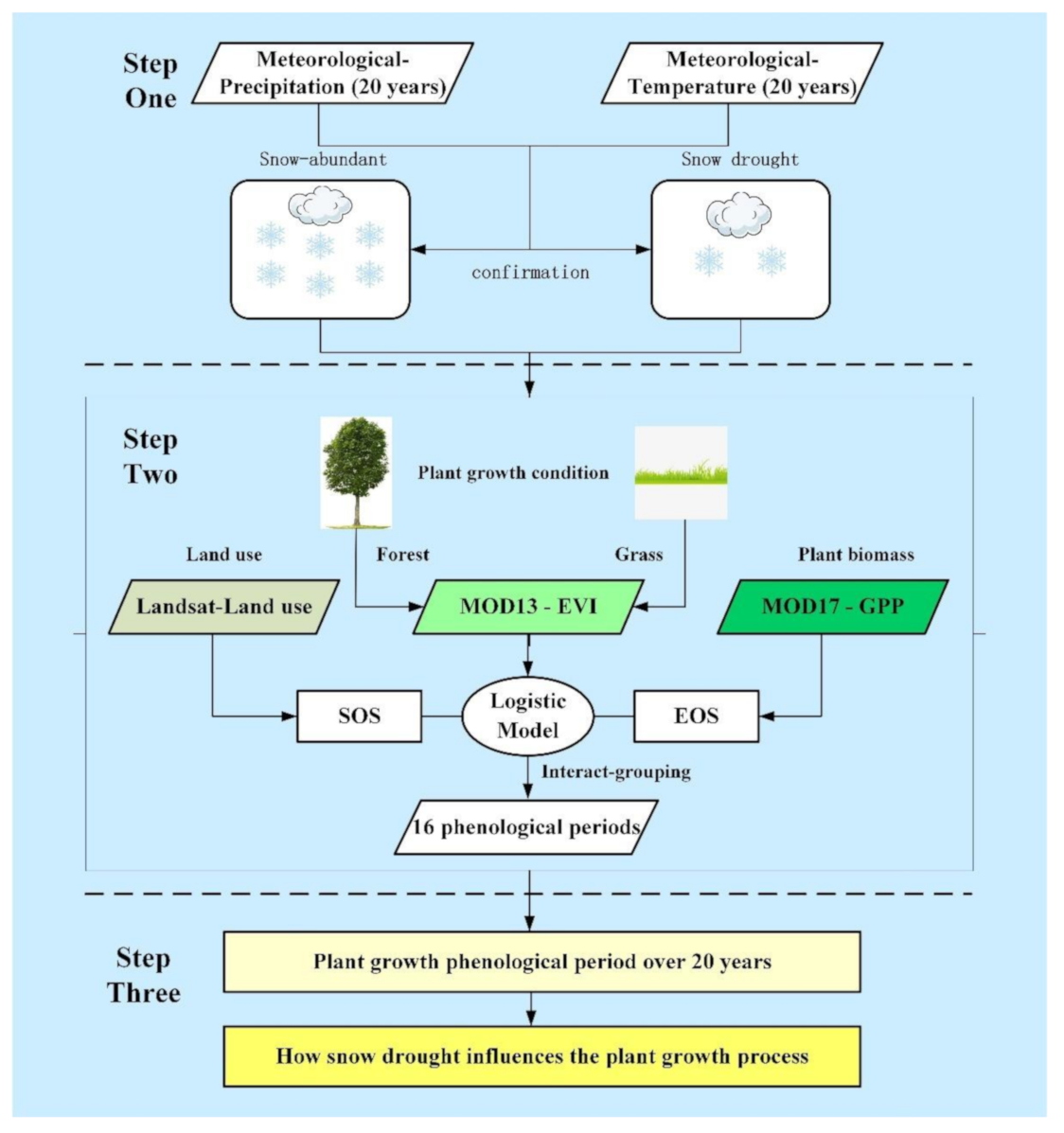

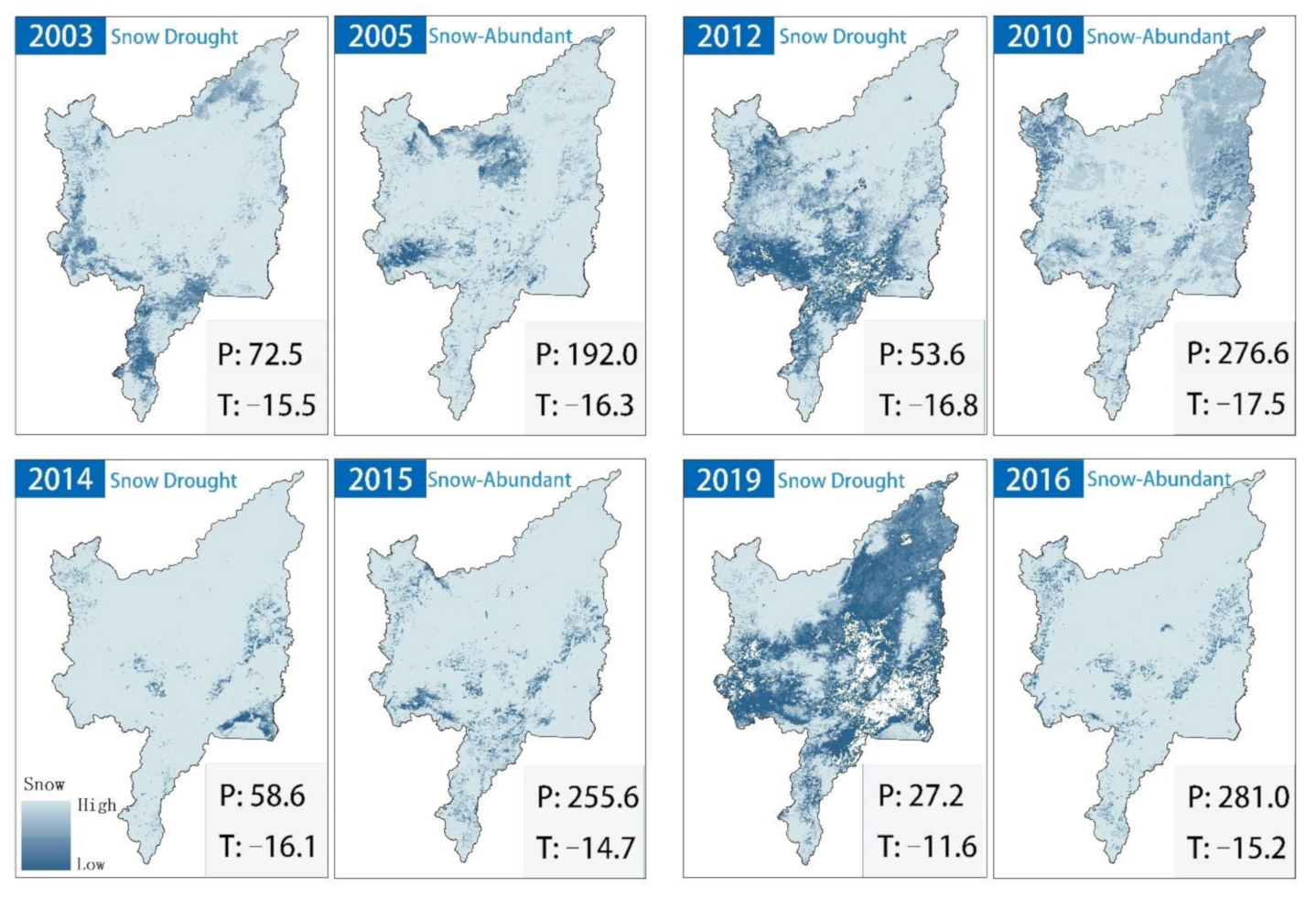


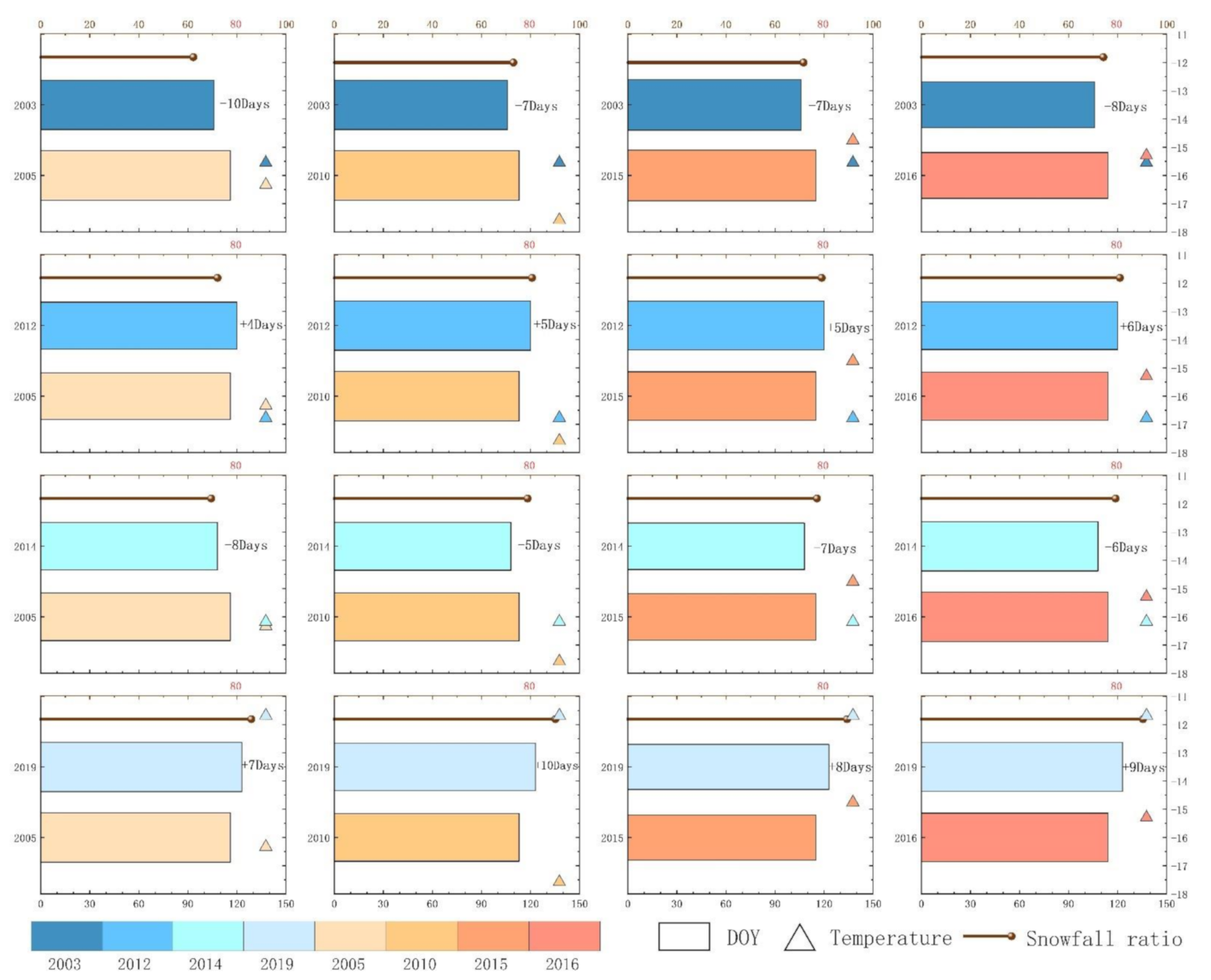
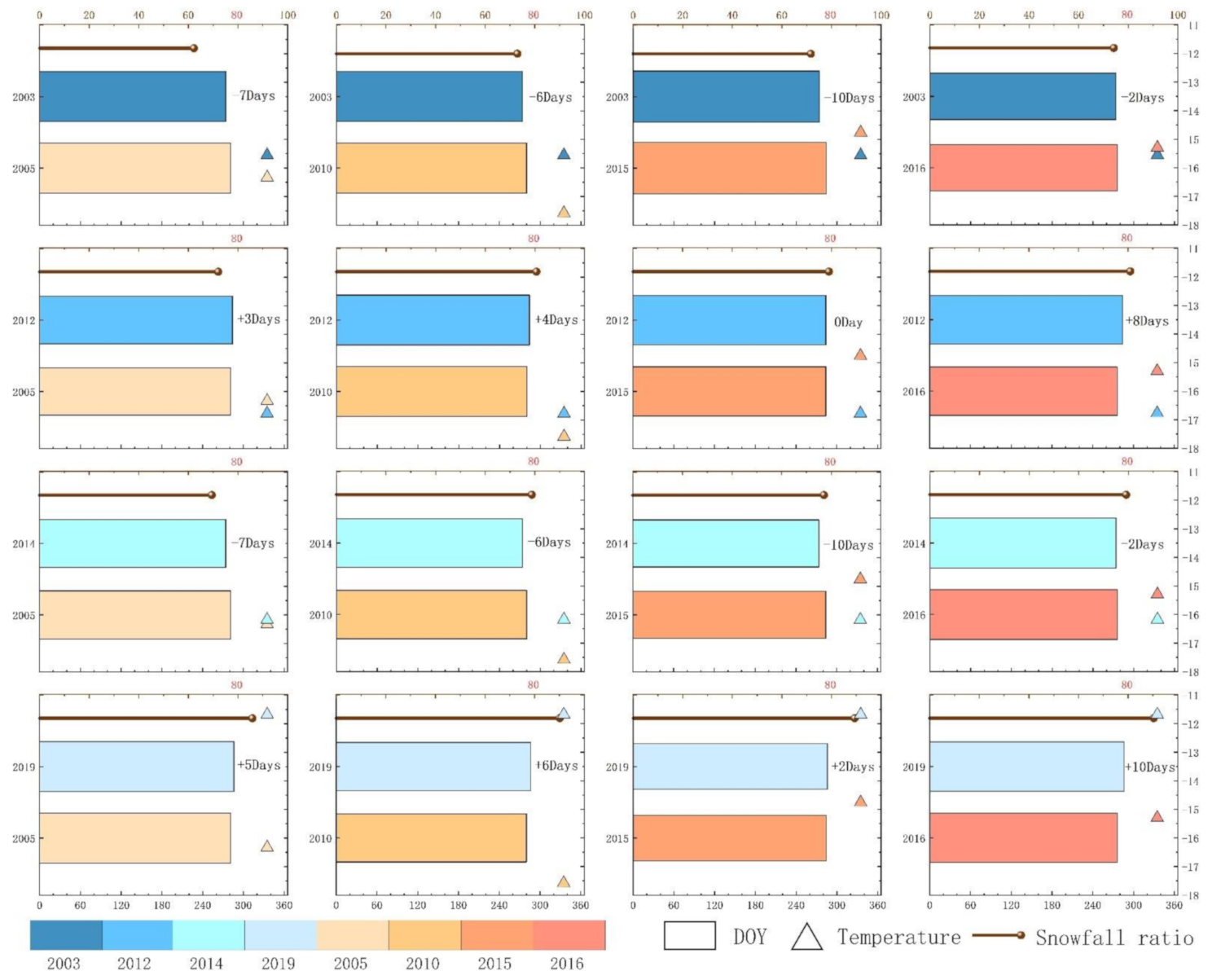
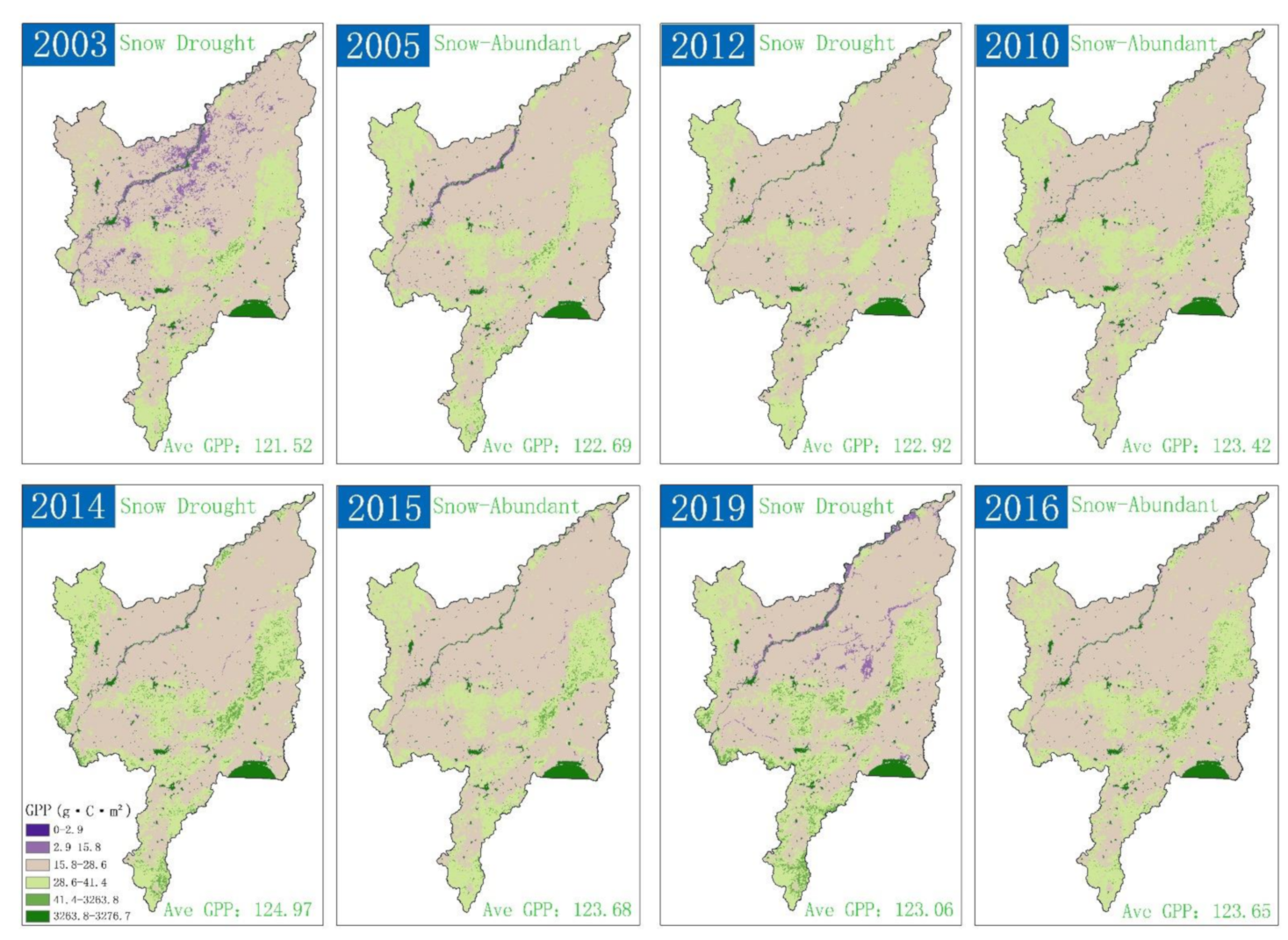
| No. | Data Name | Sensor | SR 1 | TR 2 | Date Range | Number | Role |
|---|---|---|---|---|---|---|---|
| 1 | MOD13A2-EVI | MODIS | 500 m | 16 d | 10/12/14/15/16/19 May 2003 | 224 | Phenological period |
| 2 | MOD17A2-GPP | MODIS | 500 m | 8 d | 10/12/14/15/16/19 May 2003 | 432 | Vegetation growth |
| 3 | MOD10A2-Snow | MODIS | 500 m | 8 d | 10/12/14/15/16/19 May 2013 | 432 | Snowfall |
| 4 | Landsat | TM 3/OLI 4 | 30 m | 16 d | 10/12/14/15/16/19 May 2013 | 72 | Land use |
| 5 | DOM/DSM | UAV | 5 cm | 1 d | 2019 | 272 | Land use/vegetation volume |
| Plant Species | Year | Land Use | SOS (DOY) | EOS (DOY) | Plot Type |
|---|---|---|---|---|---|
| Deyeuxia angustifolia | 2005 | Grass | 115 | 278 | AOF 1 |
| Carex lasiocarpa | 2010 | Grass | 113 | 277 | IOF 2 |
| Carex lasiocarpa | 2012 | Grass | 116 | 286 | IOF |
| Carex pseudocuraica | 2014 | Grass | 112 | 284 | IOF |
| Glyceria spiculosa | 2015 | Grass | 117 | 274 | AOF |
Publisher’s Note: MDPI stays neutral with regard to jurisdictional claims in published maps and institutional affiliations. |
© 2021 by the authors. Licensee MDPI, Basel, Switzerland. This article is an open access article distributed under the terms and conditions of the Creative Commons Attribution (CC BY) license (http://creativecommons.org/licenses/by/4.0/).
Share and Cite
Lou, H.; Wu, X.; Ren, X.; Yang, S.; Cai, M.; Wang, P.; Guan, Y. Quantitative Assessment of the Influences of Snow Drought on Forest and Grass Growth in Mid-High Latitude Regions by Using Remote Sensing. Remote Sens. 2021, 13, 668. https://doi.org/10.3390/rs13040668
Lou H, Wu X, Ren X, Yang S, Cai M, Wang P, Guan Y. Quantitative Assessment of the Influences of Snow Drought on Forest and Grass Growth in Mid-High Latitude Regions by Using Remote Sensing. Remote Sensing. 2021; 13(4):668. https://doi.org/10.3390/rs13040668
Chicago/Turabian StyleLou, Hezhen, Xijin Wu, Xiaoyu Ren, Shengtian Yang, Mingyong Cai, Pengfei Wang, and Yabing Guan. 2021. "Quantitative Assessment of the Influences of Snow Drought on Forest and Grass Growth in Mid-High Latitude Regions by Using Remote Sensing" Remote Sensing 13, no. 4: 668. https://doi.org/10.3390/rs13040668
APA StyleLou, H., Wu, X., Ren, X., Yang, S., Cai, M., Wang, P., & Guan, Y. (2021). Quantitative Assessment of the Influences of Snow Drought on Forest and Grass Growth in Mid-High Latitude Regions by Using Remote Sensing. Remote Sensing, 13(4), 668. https://doi.org/10.3390/rs13040668







